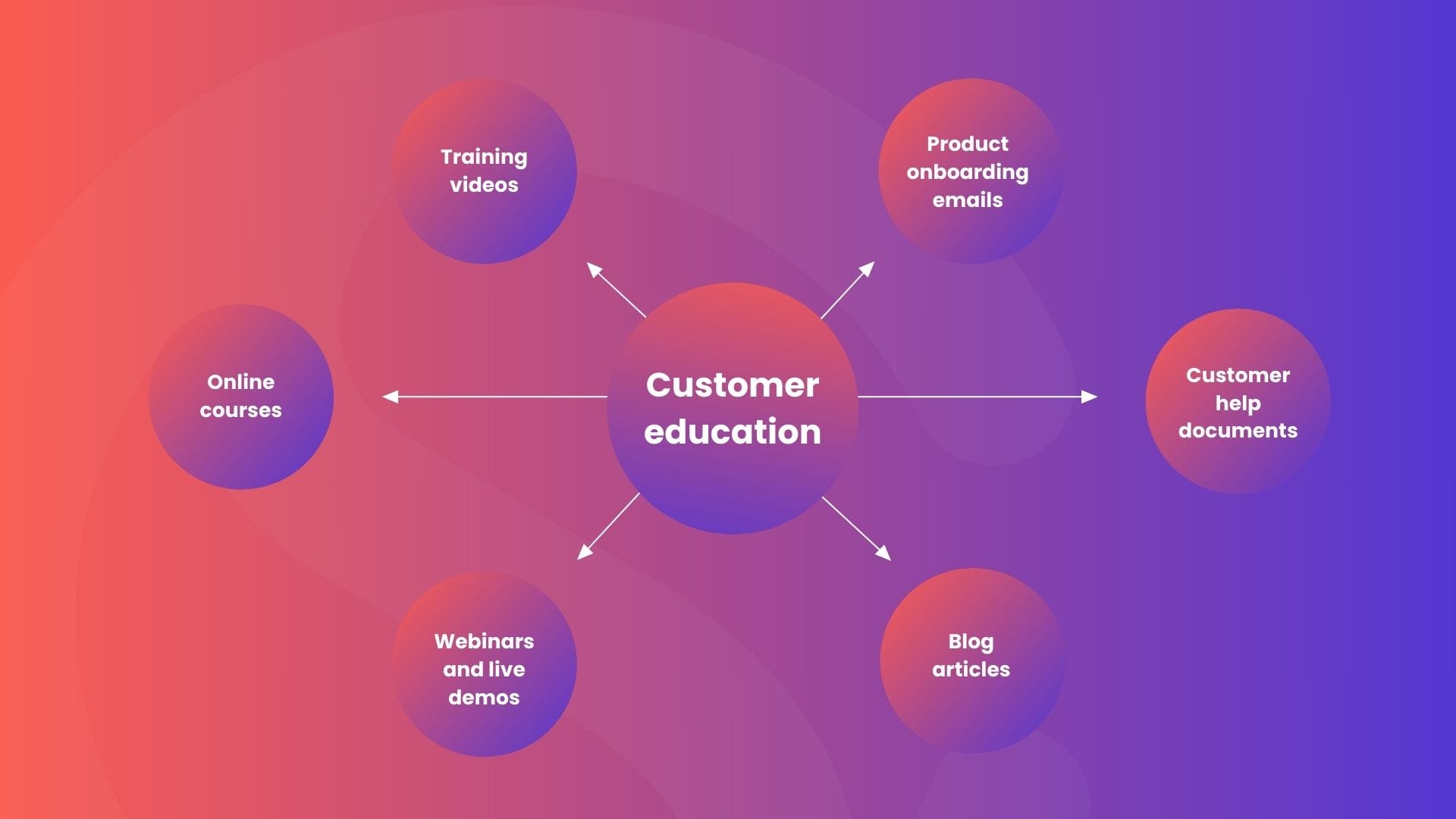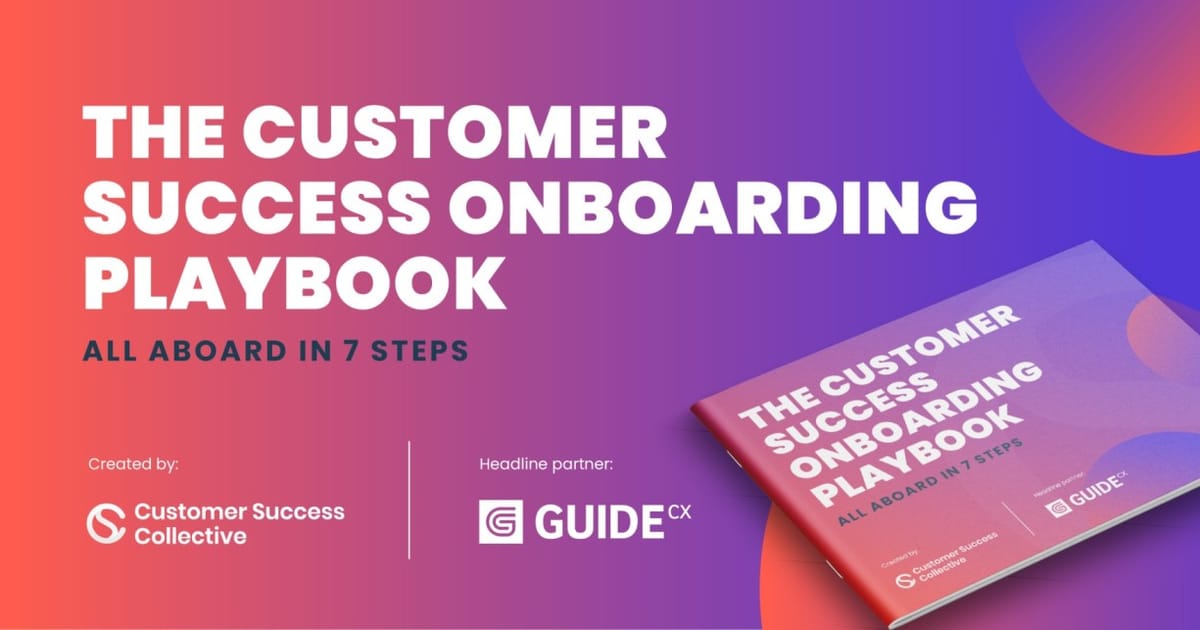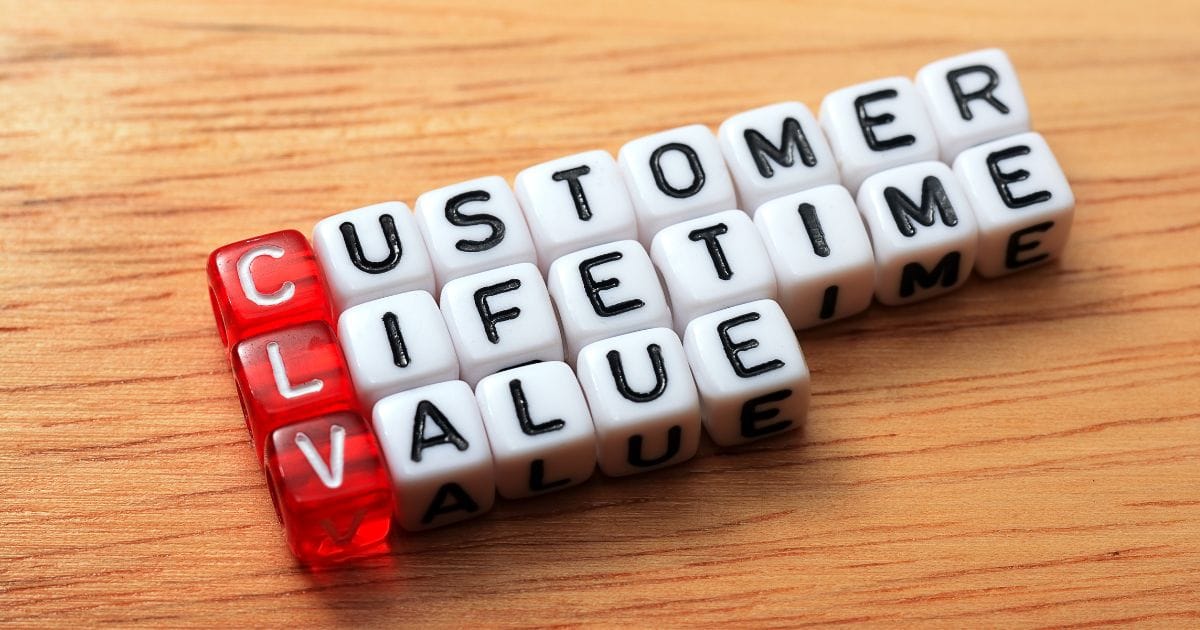If your customers aren't continuously uncovering new ways to get value from your products or services, you're missing a vital opportunity to captivate them properly. And if they don’t know how to use your product, well, there’s only one thing for it: they’ve got to learn how to use it.
An eagerness to learn is like a seed that, over time, can blossom into deep engagement and brand loyalty. To capitalize on this desire to improve, you can look no further than with customer education.
Now, “customer education” sounds pretty didactic and conjures draconian images of school days gone by. We promise you that customer education couldn’t be further removed from that.
At the end of the day, customer education is about more than just imparting knowledge – it's about sparking curiosity and inspiration. But how to do this, you might ask?
What is customer education?
Customer education plays a vital role in the customer success approach by equipping customers with the knowledge and skills needed to maximize the value they derive from a product or service.
It involves guiding new customers with tutorials and walkthroughs to effectively use your product. Comprehensive, digital educational resources are provided to deepen customers' understanding of features and troubleshooting methods.
Mediums of customer education are:
- Training videos
- Product onboarding emails
- Online courses or workshops
- Blog articles
- Webinars and live demos
- Customer help documents
Additionally, building user communities is a growth tactic to educate customers at scale, facilitating peer learning and support.
Continuously educating your customers keeps them informed about product updates, best practices, and industry insights. By empowering customers through education, frustrations are reduced, product utilization improves, and loyalty increases, positively impacting customer lifetime value.

Why is customer education important?
Research conducted by Forrester, commissioned by Intellum, reveals that an overwhelming majority, nine out of 10 companies, have experienced favorable financial returns from their investments in customer education initiatives. And it doesn't end there.
When given a lineup of four brands to purchase from, 83.6% of consumers chose the brand that provided them with educational content.
These cutting-edge programs go beyond merely supplying customers with valuable learning materials; they cultivate enduring engagement and foster a deep sense of loyalty. By moving away from outdated, manual training techniques and embracing interactive, self-guided digital platforms, companies can seamlessly align with the preferences of today's tech-savvy consumers.
This transition not only elevates the overall customer experience but also streamlines operational efficiencies, allowing teams to redirect their efforts from labor-intensive training tasks to more strategic endeavors.
Some people just put it better than others; here's what Northpass's Founder, Steve Cornwell, makes of customer education:
"If we, as leaders, begin to think about education not just during the initial onboarding but as a continuous process when new features are updated and new users get added to the platform, we can really start to see a change. This requires new infrastructure that facilitates a seamless learning experience, fully automated digital learning operations, and insights to ensure customer engagement."
What’s the difference between customer education and customer onboarding?
If you’ve ever conflated customer education and customer onboarding – don’t worry! While customer education is referred to during the onboarding process, they’re both different facets of customer success.
Onboarding refers specifically to the guided process of getting new customers up and running successfully with your product or service for the first time. It covers things like:
- Initial setup and configurations
- Account provisioning and access
- Product tours and feature overviews
- Basic workflow training
The goal of onboarding is to provide a smooth first experience that allows the customer to quickly gain familiarity and see immediate value from the core product capabilities.
Customer education, on the other hand, has a broader scope that extends well beyond just the initial onboarding phase. It encompasses ongoing training and enablement for customers throughout their entire lifecycle, aimed at driving deeper product adoption, power user mastery, and maximum value realization over time.
Some key aspects of comprehensive customer education include:
- In-depth training programs on advanced features/use cases
- Continuous learning pathways, courses, and certification tracks
- Best practice guidance and workflow optimizations
- Community forums for peer learning and peer-to-peer assistance
- Customized training for different user roles and skill levels
While onboarding is a relatively short, concentrated process, customer education is an ongoing, sustained effort to keep users engaged, proficient, and successful with your product continually over months and years.
Effective customer education builds on the foundation laid in onboarding to prevent product knowledge from getting stale and users from stagnating at basic skill levels. By investing in multi-faceted ongoing training, you empower customers to derive increasing value over time, improving stickiness and retention.

What is a customer education program – and do I need one?
It's wise to invest time and resources into developing a customer education program to ensure your customers are getting the absolute maximum value out of your product.
Here are some key reasons why a customer education program is important for your business:
1. Increase product adoption and usage
If customers don't fully understand how to use your product's features and capabilities, they won't be able to realize its full potential value. A good customer education program teaches them how to properly use the product through training materials, guides, videos, etc.
2. Reduce customer support burden
Customers who lack knowledge about the product will inevitably have more questions and issues, resulting in higher support costs for your company. Education gives customers self-service resources to find answers themselves.
3. Improve customer satisfaction and retention
When customers can get more value from the product through education, they are more satisfied and more likely to remain loyal customers for longer. Lack of education often leads to frustration and churn.
4. Open up cross-sell/upsell opportunities
The more educated customers are on advanced features, the more opportunities arise to sell additional add-ons, upgrades or complementary products they can leverage.
5. Build product experts and advocates
Great education turns some customers into product experts and passionate advocates who can provide positive word-of-mouth marketing for your brand.
You know you need a formalized customer education program when you see signals like high support costs, low product adoption metrics, negative feedback about lack of training, or churn from customers who never fully utilized the product's value. An ad-hoc approach won't cut it – you need a well-designed program.
But remember, a successful customer education program is an ongoing initiative that requires dedicated resources, cross-functional collaboration, and a commitment to continuous improvement. By investing in this effort, you can empower your customers, foster product mastery, and ultimately drive long-term success for both your customers and your business.
Why embracing digital platforms is a necessity
The last 20 years have borne witness to a shift in consumer behaviors to a “tech age.” We’ve seen an increasing demand for immediate access to knowledge about products and services that weren’t part of the playbook pre-millennium. Despite this shift, many companies still adhere to outdated, manual training methods that fail to meet these expectations, resulting in a pronounced gap between what customers seek and what businesses provide.
Traditional training methods, such as one-to-one sessions, support articles, and guides, are often resource-intensive, lack interactivity, and do not support continuous learning, directly impacting customer satisfaction and retention rates.
Transitioning to digital education platforms aligns with modern consumers' preferences, offering structured, on-demand learning opportunities that are scalable, interactive, and capable of facilitating continuous education. These platforms not only improve customer experience (CX) but also optimize operational efficiencies, enabling teams to reallocate resources from manual training efforts to more strategic activities.

From pre-sale to post-onboarding
We mentioned it at the start of this article, but it’s worth repeating for the people at the back: customer education isn’t a one-time solution during onboarding. Far from it. Your customer education journey is not a post-purchase afterthought; it's a proactive strategy that commences before the sale and should extend seamlessly into the post-onboarding phase.
This applies whether you operate in B2B, B2C, B2D, or any other business model for that matter. A well-structured, consistently updated customer education program will equip users to unearth the value in your offerings, transforming them into loyal, long-term customers and brand evangelists.
There are, of course, certain products that are easier and more intuitive than others. A robust customer education program is especially beneficial for products with intricate features, frequent updates, and those requiring extensive support. Investing in customer education is particularly prudent for products with:
- Complex features and tools
- Active release schedules with frequent updates
- A need for extensive support during user setup
- Potential for upselling and cross-selling
- High reliance on customer support
By proactively addressing these areas through comprehensive customer education, businesses can mitigate potential frustrations, accelerate product adoption, and foster a deeper understanding of the value proposition, ultimately driving customer loyalty and retention.
Real-life examples of customer education success
Qualified
One great real-life example of customer education in action comes from Qualified, the B2B marketing and sales pipeline specialists.
Qualified leveraged WorkRamp, a leading learning management system (LMS) for employee, customer, and partner learning, to revolutionize customer education initiatives. During his tenure at Qualified, former Director of Customer Education, Tony Vaughn, initiated a swift transition from a blog-centric system to an integrated customer training platform in under 30 days. The results were remarkable – trained accounts demonstrated a two-times higher renewal likelihood and more effective utilization of Qualified to develop pipelines.
The key takeaway here is that a robust digital customer education program can be a game-changer in achieving quick wins, fostering customer trust, and achieving tangible business outcomes.
Adobe
Another real-life example we can turn to for inspiration comes from Adobe. Adobe is a multinational software company known for its suite of creative software products, including Photoshop, Illustrator, InDesign, and more.
Adobe recognized the importance of educating its diverse user base on the capabilities of its powerful creative tools. To achieve this, Adobe invested heavily in creating extensive learning resources. These resources include video tutorials, step-by-step guides, webinars, and interactive learning modules that cover a wide range of skill levels and creative disciplines.
Additionally, Adobe established the Adobe Education Exchange, an online community and platform dedicated to supporting educators and students in integrating Adobe tools into the learning environment. This initiative not only provides educators with resources but also fosters a community where they can share best practices, lesson plans, and creative projects.
By combining a subscription-based model, extensive learning resources, community-building initiatives, and interactive events, Adobe has successfully transformed its customer engagement approach.
Imaginary customer education program for a SaaS product
Now, let's create our own example that helps bring some of these strategies to life. Let’s say our company is called MindfulMinds (™ pending), a SaaS company specializing in meditation and sleep improvement. MindfulMinds is looking for a way to increase engagement and product adoption.
They decide to revolutionize their onboarding process by incorporating a personalized questionnaire. New users are asked about their sleep patterns, stress levels, and any previous meditation experience during the sign-up process. This information allows MindfulMinds to tailor the initial user journey, providing personalized meditation sessions and sleep aid recommendations right from the start.
However, that’s not all to be done. Instead of only putting out a personalized onboarding questionnaire, MindfulMinds could build a comprehensive educational experience that extends throughout the entire customer lifecycle.
This could include progressive learning pathways with video courses, interactive guides, and certifications that allow users to continually level up their meditation and sleep mastery. In-app tooltips and smart wizards would provide contextual guidance based on user behavior while encouraging power users to contribute their own tips and techniques to an online community forum.
The bottom line is this: this program should have an omnichannel approach – from in-app to email campaigns to live workshops – making learning available wherever users are.
By capturing analytics on content effectiveness, MindfulMinds could also continually optimize the resources to different learning styles and goals. This holistic, data-driven approach provides the personalized support needed at every stage to drive long-term engagement and product stickiness.
Creating effective digital education content
Developing engaging and impactful value-led content is crucial for the success of a digital education program.
Content should be aligned with the target audience's needs, adopt microlearning principles for brevity and focus, and be delivered in a conversational tone to enhance accessibility. Interactive elements and real-world applications further enrich the learning experience, making the content more relatable and effective.
When crafting digital education content, it's essential to consider the diverse learning preferences of your audience.
Some individuals may prefer visual aids, such as videos or animated tutorials, while others may respond better to written guides or interactive simulations. By offering a variety of content formats, you can cater to different learning styles and increase the likelihood of effective knowledge transfer.
No matter what, your content should be organized logically and intuitively, with clear navigation and search functionality to enable users to easily find the information they need. It’s imperative you regularly update your content with new tutorials to coincide with new features releases, best practices, and industry trends. This ensures that users have access to the most up-to-date and relevant information.
Planning your customer education program
To implement a successful customer education program, your business should follow a structured approach. Here are five things to consider when planning your digital customer education program.
1. Define the scope and central goal
Identify your target audience, analyze your product or service, consult stakeholders, and set a clear central goal.
Are you aiming to engage and/or educate your whole customer base or just certain segments? If it's just certain segments, then why? How will this help you achieve your business goals? Regularly revisit these elements to ensure alignment with business objectives and customer needs.
2. Examine the post-sales process and implementation
Take a careful look at problems your customers are running into post-sale. Map the customer journey, identify pain points, and assess skill gaps. This information will help you tailor your education content to address the specific challenges and knowledge gaps faced by your customers.
3. Segment your customer base via product fit
Evaluate customer size, industry, and experience to segment customers based on their unique needs. This will allow you to tailor education plans to meet the specific requirements of each segment. For example, a large enterprise customer with a dedicated IT team may require different educational resources compared to a small business or individual consumer.
4. Gather customer renewal feedback
It's a good idea to ask for feedback on engagement and education during contract renewals. Create a process to gather that feedback so you can use it to identify areas for improvement and refine your customer education plan. This feedback can be invaluable in understanding what resonates with your customers and what areas need further attention.
5. Prioritize your research
Once you've defined your goal, spoken to stakeholders, gathered customer research through analyzing the sales process and looking at renewal feedback, and segmented your customer base, you need to prioritize. Are there any areas that need urgent attention?
If a lack of education is stopping your customers from using a particular feature altogether, for example, that is something that needs to shoot straight to the top of your priorities.
Remember, in order to create a great engagement and education program, you don't need to start completely from scratch. Use the expertise and customer feedback you already have within your team to feed into this initiative.
If you work in a larger team, you could consider creating a sub-team that looks specifically at engagement and education. If you work alone, give this initiative its own time and space within your workload. As always, communicate to leadership that you're doing this work because it contributes to key metrics such as customer lifetime value, customer satisfaction scores, and churn rate.

Vetted educational content
A crucial aspect of an effective customer education program is ensuring that the content provided is accurate, up-to-date, and aligns with your product's best practices. Developing high-quality educational materials requires a structured approach to content creation, review, and maintenance.
One way to achieve this is by establishing a dedicated team or working group responsible for overseeing the customer education content. This team should consist of subject matter experts, product managers, and experienced users who possess deep knowledge of your product or service.
The content creation process should involve the following steps:
- Content ideation: Identify knowledge gaps, common user queries, and areas where customers may benefit from additional guidance based on data from support tickets, user communities, and customer feedback.
- Content development: Subject matter experts (SME) should create initial drafts of the educational content, adhering to established guidelines for formatting, tone, and style.
- Content review: The draft content should undergo a rigorous review process by the working group, ensuring accuracy, clarity, and alignment with best practices.
- Content validation: Conduct pilot testing with a select group of customers or power users to gather feedback on the effectiveness and usability of the educational materials.
- Content publication: After incorporating any necessary revisions, publish the vetted content on your customer education platform or distribute it through appropriate channels.
- Content maintenance: Regularly review and update the content to reflect product updates, new use cases, or changes in industry best practices.
By implementing a structured process for content development, review, and maintenance, you can ensure that your customer education program delivers reliable, high-quality information that empowers your customers to maximize the value they derive from your product or service.
Measuring success to get leadership buy-in
Measuring the success of a digital education program involves tracking various metrics across different phases, from content development and learner engagement to the program's impact on business KPIs such as renewal rates and product adoption.
These metrics provide a comprehensive view of the program's effectiveness and help in securing continued support from leadership by demonstrating ROI. Here's a breakdown of the three phases we recommend you follow:
| PHASE 1: 6 MONTHS | PHASE 2: 6-12 MONTHS | PHASE 3: 12 MONTHS+ |
|---|---|---|
|
Focus metrics on content development status and launch readiness: |
Shift to usage and reaction metrics show- casing learner engagement: |
Expand metrics to correlate education impact on business KPIs: |
| ✅ Course completion rates | ✅ Registration rates | ✅ Customer renewal rates |
| ✅ Content volume developed | ✅ Ratio of active learners | ✅ Product adoption levels |
|
✅ Subject matter expert input secured |
✅ Course satisfaction scores | ✅ Reduced support tickets |
| - |
✅ Self-reported confidence gains |
- |
While later phase metrics offer the most meaningful ROI insights, we suggest you recognize data dependencies and set leadership expectations accordingly within regular check-ins.
It's also essential to communicate the value of customer education programs to leadership by tying them to broader business objectives. For instance, you could demonstrate how improved product knowledge and adoption among customers can lead to increased customer lifetime value, reduced churn rates, and even opportunities for upselling and cross-selling.
By presenting a clear ROI and aligning the customer education program with strategic business goals, you can gain leadership buy-in and secure the necessary resources and support for its successful implementation and ongoing improvement.

Final thoughts about customer education
The shift towards digital customer education is a strategic imperative for organizations aiming to enhance customer loyalty and competitive advantage.
By offering structured, self-paced, and interactive learning experiences, businesses can meet modern consumers' expectations, improve satisfaction, and drive loyalty. The integration of digital education platforms not only benefits customers but also optimizes business operations, making it a win-win strategy for advancing customer success initiatives.
As customer expectations continue to evolve, positioning continuous learning at the heart of customer relationships will be key to maintaining relevance and fostering lasting customer loyalty. By empowering customers with the knowledge and skills they need to fully leverage your products or services, you not only create a superior customer experience but also cultivate a loyal and engaged user base.
So in an era where customer loyalty is the ultimate currency, investing in digital customer education is a wise and future-proof strategy. By prioritizing continuous learning and knowledge transfer, businesses can differentiate themselves, build stronger relationships with their customers, and ultimately drive long-term growth and success.
Re-familiarize yourself with the essentials of customer success
Looking for a well-rounded course that teaches the fundamental properties of customer success? Then look no further than our flagship course, Customer Success Core: Certified.
Accelerate your customer success career with the most cutting-edge and comprehensive curriculum around, and walk away with new knowledge, tried and tested strategies, and a competitive edge.
By the end of the course, you'll:
🧠 Understand the full breadth of the CS function.
💪 Be armed with all and only the most up-to-date and successful CS tactics and trends.
📈 Up-skill yourself in every core competency required for your role, and prove your strategic value.
🏆 Tap into the proven strategies used at some of the world’s most innovative and established brands.
🔖 Earn an official certification to boost your resumé and accelerate your career.



 Follow us on LinkedIn
Follow us on LinkedIn




